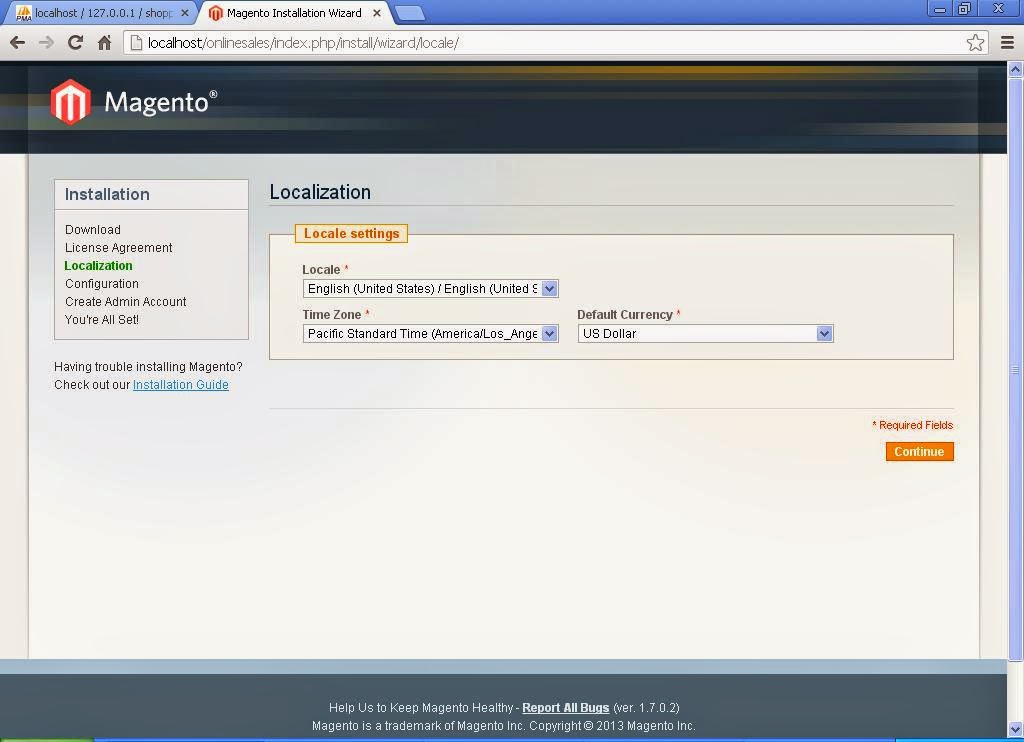After completing installation we are able to understand directory structure..
The root directory structure
You are free to set your local Apache virtual host and host file
to any domain you prefer, as long as you keep this in mind. If you're hearing
about virtual host terminology for the first time, please refer to the Apache
Virtual Host documentation at http://httpd.apache.org/docs/2.4/vhosts/.
Here is a quick summary of each of those files and folders:
.htaccess: This file is a directory-level configuration file supported by
several web servers, most notably the Apache web server. It controls mod_rewrite for fancy URLs and sets configuration server variables (such as
memory limit) and PHP maximum execution time.
.htaccess.sample: This is basically a .htaccess template
file used for creating new stores within subfolders.
api.php: This is primarily used for the Magento REST API, but can be
used for SOAP and XML-RPC API server functionality as well.
app: This is where you will find Magento core code files for the
backend and for the frontend. This folder is basically the heart of the Magento
platform. Later on, we will dive into this folder for more details, given that
this is the folder that you as an extension developer will spend most of your
time on.
cron.php: This file, when triggered via URL or via console PHP, will
trigger certain Magento cron jobs logic.
cron.sh: This file is a Unix shell script version of cron.php.
downloader: This folder is used by the Magento Connect Manager, which is
the functionality you access from the Magento administration area by navigating
to System | Magento Connect | Magento Connect Manager.
errors: This folder is a host for a slightly separate Magento
functionality, the one that jumps in with error handling when your Magento
store gets an exception during code execution.
favicon.ico: This is your standard 16 x 16 px website icon.
get.php: This file hosts a feature that allows core media files to be
stored and served from the database. With the Database File Storage system in
place, Magento would redirect requests for media files to get.php.
includes: This folder is used by the Mage_Compiler extension
whose functionality can be accessed via Magento administration System | Tools
| Compilation. The idea behind the Magento compiler feature is that
you end up with a PHP system that pulls all of its classes from one folder, thus,
giving it a massive performance boost.
index.php: This is a main entry point to your application, the main
loader file for Magento, and the file that initializes everything. Every
request for every Magento page goes through this file.
index.php.sample: This file is just a backup copy of the index.php file.
js: This
folder holds the core Magento JavaScript libraries, such as Prototype,
scriptaculous.js, ExtJS, and a few others, some of which are from Magento
itself.
lib: This folder holds the core Magento PHP libraries, such as
3DSecure, Google Checkout, phpseclib, Zend, and a few others, some of which are
from Magento itself.
LICENSE*: These are the Magento licence files in various formats (LICENSE_ AFL.txt, LICENSE.html, and LICENSE.txt).
mage: This is a Magento Connect command-line tool. It allows you to
add/ remove channels, install and uninstall packages (extensions), and various
other package-related tasks.
media: This folder contains all the media files, mostly just images
from various products, categories, and CMS pages.
php.ini.sample: This file is a sample php.ini file
for PHP CGI/FastCGI installations. Sample files are not actually used by the
Magento application.
pkginfo: This folder contains text files that largely operate as debug
files to inform us about changes when extensions are upgraded in any way.
RELEASE_NOTES.txt: This file contains the release notes and changes for various
Magento versions, starting from version 1.4.0.0 and later.
shell: This folder contains several PHP-based shell tools, such as
compiler, indexer, and logger.
skin: This folder contains various CSS and JavaScript files specific
for individual Magento themes. Files in this folder and its subfolder go hand
in hand with files in app/design
folder, as these two locations actually
result in one fully featured Magento theme or package.
var: This folder contains sessions, logs, reports, configuration
cache, lock files for application processes, and possible various other files
distributed among individual subfolders. During development, you can freely
select all the subfolders and delete them, as Magento will recreate all of them
on the next page request. From a standpoint of a Magento extension developer,
you might find yourself looking into the var/log and var/report folders every now and then.
















